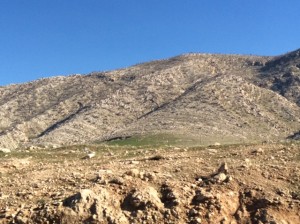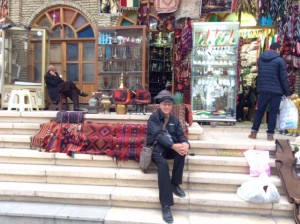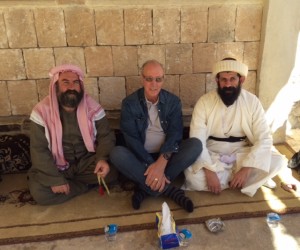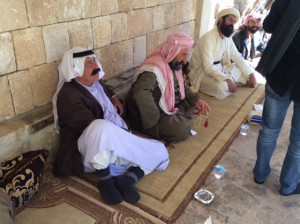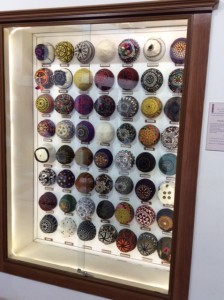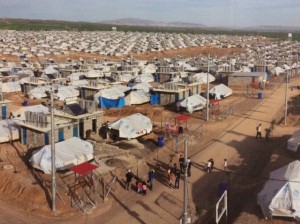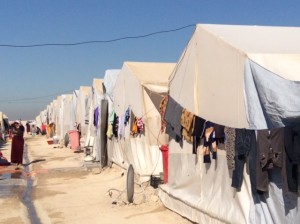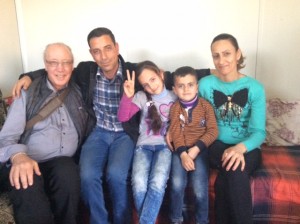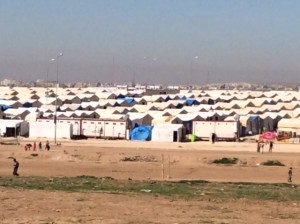The World has Discovered the Yezidis
The Yezidi people have suddenly emerged into our collective conscience. Several years ago very few of us had ever heard of this religious community never mind its history. Unfortunately it takes a catastrophe to allow information to squeeze past our preoccupation with sports, the weather or the current political gong show.
When 5,000 young women are kidnapped and quite literally disposed of to ISIS fighters through sex slave auctions – with the price based on youth and beauty – the world suddenly takes notice even if it does very little to help. (John Kerry stated March 17 that the ISIS actions against the Yezidis constitutes genocide.)
The Yezidi are one of the historic religious minorities in the Middle East that reach back to the dawn of civilization. They are in year 6764 of their calendar – 1000 years older than the Jewish calendar. I had the privilege of visiting Kurdistan in February. The visit included the Yezidi, displaced Christians and Kurds in February and I returned with many impressions but an undoubtedly incomplete understanding.
I had the benefit of advice and perspective by consulting senior Christian and Yezidi scholars in the region. Their views are reflected in the specifics of the description of the Yezidi religion and some of their political and social observations.
The photos and the essay do not identify my colleagues or the people we visited who are working in the region. This is for their protection.
I asked one of their leaders when the Yezidi faith or tradition had its beginning and he responded with a surprised look “It has always been”. They are sometimes described as a “pre-Abrahamic” religion with elements of Zoroastrianism and share elements and practices that we would associate with Judaism, Christianity and Islam. The Yezidi originate in the same part of the world from which Abraham emerged according to our Jewish and Christian traditions. We should not be surprised if the tribal movement we call “Abraham” carried with it experiences, ideas and practices that were known and practiced.

The Citadel of Erbil – a historic tell or mound. Claims are that Erbil is the oldest continuous inhabited city in the world.
The Yezidi practice monotheism and when I asked if they distinguished their Allah or God from the God of Christians or Islam they very clearly state there is only one God. We have traditionally given all or most of the credit for monotheism to the Jews but possibly the idea and credit needs to be shared a little. The Yezidi religious pantheon includes seven angels. Melek Taus is the Creator God who is revealed as the Peacock Angel.
The usual information about Yezidis states that Muslims accuse them of being devil-worshippers because the name of one angel sounds similar to the Arabic word for Satan. A Yezidi scholar corrects this perception and states that on the contrary the Yezidi theology has no place for negative celestial forces – unlike Christianity or Islam. Muslims have used this as an excuse to label them in a negative way.
Yezidis view God as remote or holy and can only be approached through these Angels. (Arguably the early Jewish practices in the temple and the way Jesus is used in Christianity – or Mary in Catholicism may not be all that different.) Daily worship and devotion is individual but festive worship is corporate. Festive worship is made up of sermons, chanting of hymns and recitation of sacred texts. Nothing is in written form – both faithful and clergy should know all the liturgical texts by heart.
We had the opportunity to observe worshippers enter and worship in their most holy temple in Lalish. Pillars were covered with fancy cloth and the worshipper would stand in front of each pillar, look up with hands held up in supplication and then tie a knot somewhere in the fabric to complete the act of prayer or worship.
The Yezidi heartland is in the region that is today northern Iraq and in areas shared with the Kurds. The Yezidi identity is racial and one can only be or become Yezidi through birth – another tradition shared with Jews to the extent that jewishness is racial. As a result they do not proselytize and this may account for being considered a peaceful group – they did not have the imperative to capture other nations, land and territories in the manner of traditional empires.
Yezidis form a theocratic society which is governed by the highly hierarchical Supreme Council – Majlis Rohani, led by Emir Thasin Beg and Baba Sheikh Khato. The society is divided into three castes: Sheikhs, Firs and Mourids. Sheikhs and Firs are believed to be descended from the ancient saints.
Yezidis will state that historically they were a much larger population – using numbers as large as 20 million. Today Yezidis number less than one million with the majority still living in their historic lands. The only significant diaspora is an estimated 150,000 in Germany who relocated there in very recent times. Yezidis speak Kurdish and a little Arabic and some argue that the Kurds are really Yezidis who converted to Islam by force or otherwise over the last 14 centuries.
The world was surprised and shocked by the unique and barbarous attack on the Yezidi population by ISIS in August 2014. Although seriously mistreated and abused by ISIS, most Christians and Shia were given opportunity to escape with their lives if little else during the dramatic events in Central Iraq. The now infamous events around Sinjar and Sinjar Mountain, the area with the largest Yezidi population, have now been added to our shameful list of human atrocities.
When ISIS attacked the Sinjar villages on August 3, 2014 the Yezidi view is that the Kurdish peshmerga forces defending the area abandoned them – leading to the publicized catastrophe. This has been viewed as a betrayal and will only add to the difficulty of future reconciliation, cooperation and unity.
Since we knew so little about the Yezidi we were collectively surprised when ISIS singled them out for such barbarous treatment. The explanation given is that Islam generally has considered Christians and Jews as “people of the book” together with Muslims. Although still considered infidels with various degrees of accommodation or persecution during the course of history, they are distinguished from groups that do not share this degree of commonality. Yezidis are unfortunately outside of this limited sense of shared identity.
The Yezidi may be candidates for the most persecuted group on earth if one considers persecution as arising primarily from their identity over time. While they do not have a robust written tradition they seem to remember their history of mistreatment with some precision. They claim something like 170 specific and important periods or events of persecution reaching back several thousand years. That works out to an average of one significant event every generation. The catastrophe being experienced by the current generation adds to this tragic list.
(I was advised that many unpublished manuscripts exist and are kept by the Firs but do not have the extensive written tradition comparable to Judaism and Christianity.)
We are all aware of the Armenian genocide in Eastern Turkey a century ago. One of the Yezidis stated matter of factly that they had historically shared that region and similar suffering “but we do not have the benefit of a powerful diaspora or shared religion to make our story known.”
The center of the Yezidi religion or tradition is a temple located at Lalish a short distance east of the Kurdish City of Duhuk. The temple is located in a narrow valley and surrounded by historic buildings. What is notable to a visitor is that many natural elements such as large stones, rough canyon walls and gnarled ancient trees have been left in place – as if they form part of the totality of the temple. The most notable element of the temple is a series of short spires that reach to the sky. The Yezidis were afraid that the Lalish temple might become victim to the current conflict and as security have built a modern version of the Lalish temple in Tbilisi, Georgia. I had the privilege of visiting the new temple and its leadership in May, 2015.
Although we arrived at the temple unannounced we were welcomed graciously, taken on a tour of the temple and introduced to Baba Sheikh, the leader in charge of the temple. We discussed the purpose of our visit and were invited to join him for lunch. Adjacent to the temple is a small covered pavilion where Baba and other elders were sitting and engaged in discussions with passersby, visitors and each other. It reminded us of the Old Testament images or ancient Greece where the elders or wise men sat at the City Gates and engaged with their world. Note the photographs – some of them could have been taken a thousand years ago and would have looked the same – until you note the photo with Baba Sheikh on his mobile phone!
Yezidis have often been described as nature-worshippers suggesting an element of paganism. They acknowledge the sun as the ultimate example of creation and this is reflected in their worship – but they state that is different than describing the sun or other elements of nature as God.
The temple is entered through a very low door as a symbol of humility. The interior includes two parallel chambers framed by arches and joined by other arches. This results in seven pillars to represent the seven angels. Each pillar is wrapped in layers of very colorful and expensive satin. Worship includes tying a knot at the conclusion of a prayer.
The temple is tight against a canyon wall. Inside the canyon rock are a series of parallel chambers which predate the current temple. They contained ancient clay jars formerly used to store olive oil. There were a series of rock niches left in their natural organic shapes and evidence of locations to light candles for worship. A final chamber went deep into the ground through a narrow tunnel. This tunnel accessed water and is used for the purpose of an inclusive religious initiation for boys and girls. Initiation also includes circumcision for boys and the cutting of hair for both boys and girls.
We were advised that the region had been dominated by the Muslims from the inception of Islam. Many of the records had consequently been lost and we were told that the temple had even been used as a mosque for a while. This has limited their knowledge of their own history.
The explosion of ISIS plus the Syrian civil war affected many religious and ethnic communities but in different ways. Individual families and villages may be uprooted but in many cases their religious communities as a totality are not affected. The Middle East will remain predominantly Sunni and Shia and both groups have safe havens if they need to relocate. Minorities such as the Alawites in Syria could be in serious trouble if Assad is replaced. The Jewish populations abandoned their historic communities after the creation of Israel – but at least had a destination which preserved their sense of community. Middle East Christians have been a slowly unfolding tragedy for a century. Their presence in the region had been reported to have declined by 75% before the Iraq wars and the Arab Spring. When the Middle East dust settles – do not hold your breath – there may be nothing left but a few isolated Christian groups such as in Lebanon.

Textile museum in the Erbil Citadel – Kurdistan shares the ancient regional practice of producing beautiful carpets.
It is tragic to speak to the Bishops and Archbishops representing the historic 2000 year old churches of the region. They are desperate to sustain the Christian presence but have nothing to promise in terms of a secure future. We spoke to families from Mosul and other towns of the historic Nineveh Plain. “We have lived peacefully with our Muslim neighbors for generations – but when ISIS arrived they betrayed us (to ISIS) and we fled for our lives – how can we go back to live with those neighbors again.”
Then there are the Yezidis who have been so traumatized they really have little idea about their future. Return to towns surrounded by people who did not support them will be difficult. The majority of the Yezidi population lives in refugee camps in northern Kurdistan and some in Turkey. We had the opportunity to visit and walk through the largest of these camps. Over the last 50 years I have visited dozens of refugee camps around the world. What was noticeable about this visit was the complete absence of smiles. Even when things are tough refugees exhibit some recognition of visitors and their presumed good intentions. The men were largely absent and the women were doing an amazing job of keeping a conglomeration of thousands of tents built on sand in immaculate condition.
These are the people who lost and are mourning the 5,000 enslaved girls plus the massacre of their men and those women not useful for sexual purposes. These are the survivors of Sinjar Mountain where they were trapped in extreme summer heat without food or water while most of the world limited itself to wringing of hands and watching “breaking news”. The re-capture of Sinjar Mountain and the town of Sinjar is publicly credited to the efforts of the peshmerga – but the Yezidis hold the peshmerga responsible for the initial massacre by their failure to assist in the defense. This is a highly traumatized population and healing will take time.
(Some Yezidis do fight alongside the peshmerga but we came to understand that the level of distrust is high and given the political realities the Yezidis are reluctant to state this openly.)
We visited with a Yezidi researcher who is documenting aspects of this tragedy. There are a known 300 of these girls who have been rescued from ISIS – some girls were as young as 10! Most are being ransomed at various prices and one can only imagine the dangerous nature of this kind of activity. Individual stories are reaching the world but he wants to interview each girl or woman that is rescued and record and honor their suffering so that rest of the world has less excuse to pretend that we do not know.
Some of the Yezidi women who have been ransomed or escaped undoubtedly face a difficult future in terms of marriage and family. A number from this group have created a female military brigade that fights alongside the Kurdish peshmerga – who also have female brigades. They state their purpose is to rescue some of their ‘sisters’ still in captivity – and I would suspect that when they meet their former captors little mercy will be shown!
The purpose of our visit was to identify the nature of the refugee problem as it affects University students whose studies have been disrupted. There is a general impression that Yezidis are more rural, more traditional and therefore an assumption that University is not a high priority. The reality surprised us. Many Yezidis attended University in the past or would like to and the absence of restrictions on females compared to the surrounding Muslim culture means they are more free to attend and participate. We were told repeatedly that Yezidis compete very effectively in the University environment and it was not unusual that the top student in a class of mixed religions was Yezidi. Our objective will be to identify these exceptional students, first to give them opportunity but also to create a positive and constructive image of this community. Although some students are admitted to local Kurdish Universities there are many restrictions and problems which make the opportunity theoretical for most.
It is difficult to know how to assist or intervene with such a unique and traumatized group. Given the importance of racial identity they have fewer options than other groups. If scattered as individuals or even families they may survive physically but without that critical sense of community. The UNHCR has the policy of not listing religion or race on its documents and countries like Canada share in that policy. The idea of neutrality is commendable but every person we met in Kurdistan was defined by their identity. Their prior experience, reason for persecution, access to services, future opportunities, ability to travel and more were all linked to identity. Neutrality is a notion that is best left to academia. When considering the Yezidis, dispersing the group may in fact be an act of cultural genocide.
Any slightly informed reader will note that I have not discussed the Kurds or Kurdistan. We arrived in Erbil with no visa or letter of introduction. We cleared passport and customs in about 5 seconds. The Kurds are absolutely in charge and Iraqi sovereignty is a theoretical notion. This is as close as the Kurds have come to a country of their own and the debate about a Declaration of Independence rages.

The Kurds say the mountains are our friends – they have contributed to their ability to protect their territory.

Kurdish village posing for a photo in 1970. In 1977 this village and hundreds more were bulldozed by Saddam Hussein.
The Kurds and Yezidis share a language and significantly overlap geographically. They probably have emerged from the same original population. Many historians have noted that the Kurds were the one group left out when the borders were rearranged (Paris in 1919) following the collapse of the Ottoman Empire. Given that the Yezidi have so much cultural and linguistic overlap – the Kurds have suddenly re-discovered a forgotten kinship – or conveniently a kinship with political ramifications. The Yezidi occupy territory to the northwest of the main Kurdish part of Iraq and incidentally there is oil under their lands. The Kurds have calculated that if they can create some form of Kurdistan – it would be politically and economically very convenient to have the Yezidi areas identify as part of Kurdistan instead of Iraq. The colorful maps from the war in Syria show virtually the entire border area on the Syrian side between Syria and Turkey controlled by the Syrian Kurds. Now consider a future Kurdistan that in addition to the historic mountain areas of Northeast Iraq would include a strip that includes all or most of the border with Turkey. Given the political incompatibility of the Kurds inside Turkey and the government of Turkey you can already see the outlines of a future conflict (not so future if you note the recent news) that could go on for generations.
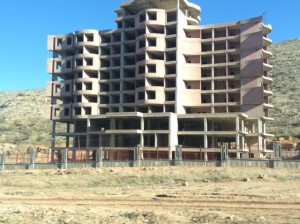
Kurdistan was booming until ISIS attacked in August 2014. Now hundreds of buildings like this are abandoned.
The Canadian Government may play an interesting and unintended role in this outcome. The incoming Liberal Government promised to withdraw Canadian fighter jets from the fight against ISIS and has in fact done so. Under pressure to contribute in some way to the coalition against ISIS, the Government of Canada found it politically more acceptable to send additional military advisors and trainers to assist the peshmerga. The Kurds have always been tough but now they are becoming the most battle-hardened and effective force in the region and one that has relatively few internal divisions. Canada may not be dropping bombs but is contributing to the ability of the Kurds to become independent – and in doing so will contribute to the effort by Kurds inside Turkey to fight for more autonomy.
However, that is another essay!

